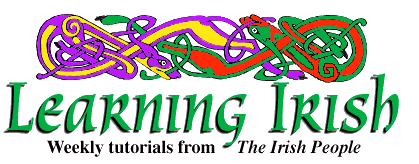
Irish Lesson 39
| PRONUNCIATION EXERCISE Read the phrases below out loud, referring to the pronunciation guide if necessary. When you can read the phrases readily, look at the translation and then go over the phrases again, visualizing the meaning as you say each. Pronunciation Irish pronunciation of some words varies from region to region, just as in other countries, such as Germany, France, and the United States. Ireland is small in size, compared to those countries, however, and the variations in the pronunciation in Ireland are less evident than in most countries in Europe. If you are working with a fluent or native speaker, you have undoubtedly encountered some differences between our simplified pronunciation guide and the pronunciation of the speaker. Our pronunciation guide tries to give you a system which will be easy to apply, fairly uniform and consistent, and readily understood over as wide an area of Ireland as possible. It is not tied exclusively to any single region. From time to time, we will describe some of the regional variations in pronunciation. There are three basic regions in Ireland, as far as the language is concerned: Munster, in the south; Connaught, in the west; and Ulster, in the north. One general rule on pronunciation difference among the three regions is that accent in a word tends to be toward the end of the word in Munster, toward the front in Ulster, and evenly distributed in Connaught. For example, with "agam", on me, the Munster pronunciation is (uh-GUHM), and the Ulster pronunciation is (AH-guhm). In Connaught, the pronunciation is (ah-guhm), with a more even distribution of accent. "Thank you" is pronounced (gu-ruh-MAH-huh-guht) in Munster and (gu-ruh-muh-HAH-guht) in Connaught. Brief experience with pronunciation differences of this kind will make them readily understandable, just as they are in English. Whether you say (eye KANT) or (eye KAHNT) for "I can't", you will understand (ah KAYNT) from some speakers from the southern United States.
Pronunciation exercise Read this passage slowly without looking at the key below it. Then read it a second time, making use of the key if you are unsure. Do not try to make sense of the words; concentrate on the pronunciation and on grouping the words into phrases: Is iad an cineál dreama, gur leag siad síos, an bhunsraith, go bhfaca sé ceadmhach sa dara cás, an smuta mailíseach seo, roimh iarratais ar an bpost, a thug sé formhór a shaoil. As sin amach, gur toradh meatachta is mímhacántachta, agus bíonn na tuismitheoirí as an iarsma, le linn na gcúirteanna dóibh siud a bheidh i láthair. SHEE-uhd un KIN-aw*l DRAM-uh gur lag SHEE-uhd shees uh vun-SRAH, goh VAHK-uh shay* KAD-uh-vwahk* suh DUH-ruh kaw*s, un SMUT-uh mahl-ee-SHAHK* shuh, rev EER-uh-tish er un bohst, uh hug shay* fohr-uh-VWOHR uh HEEL. as shin uh-MAHK*, gur TOHR-uh MYA-tuhk*t-uh is mee-vuh-KAW*N-tuhk*t-uh, AH-guhs BEE-uhn nuh toosh-mi-HOH-i-ree as un EERS-muh, le lin nuh GOO-ir-tyan-uh, DOH-iv shood uh ve i LAW*-hir.
Grammar In the present habitual tense, some verbs have slightly different forms from the forms that you began to learn last week. These verbs are the same two-syllable ones that you studied in Lesson 27. These verbs have forms like "cheannaíomar" (hyan-EE-uh-muhr), we bought, in the past.
To say "I buy", etc., the forms are: ceannaím (kan-EEM), I buy ceannaíonn (kan-EE-uhn) tú, you buy ceannaíonn sé, he buys ceannaíonn sí, she buys ceannaímid (kan-EE-mid), we buy ceannaíonn sibh, you (pl.) buy ceannaíonn siad, they buy
And then: ní cheannaím (nee hyan-EEM), I don't buy cheannaíonn (nee hyan-EE-uhm) tú, you don't buy, etc. an gceannaím? (un gyan-EEM) do I buy? an gceannaíonn tú? (un gyan-EE-uhn too), do you buy, etc.
Vocabulary seacht gcarr (shahk*t gahr), seven autos ocht gcarr (ohk*t gahr), eight autos naoi gcarr (nee gahr), nine autos deich gcarr (de gahr), ten autos
snámh, ag snámh (snaw*v, uh SNAW*V), swim pós, ag pósadh (pohs, uh POHS-uh), marry clis, ag cliseadh (klish, uh KLISH-uh), fail érigh, ag éirí (EYE-ree, eg EYE-ree), rise, get up
Drill To improve your fluency with the present habitual tense and with aspiration and eclipses of initial "d" and "f", go through these four progressive drills: An ndíolaim nuachtáin? (un NEE-lim NOO-uhk*-taw*-in) Do I sell newspapers? Ní dhíolaim nuachtáin (nee YEE-lim NOO-uhk*-taw*-in). Díolann tú (DEE-luhn too) nuachtáin. An ndíolann tú nuachtáin? Ní dhíolann tú nuachtáin, etc. The last sentence is: Díolaim nuachtáin.
An ndúnaim na fuinneoga? (un NOON-im nuh fwin-YOHG-uh) Do I close the windows? Ní dhúnaim (nee GOON-im) na fuinneoga. Dúnann tú (DOON-uhn too) na fuinneoga, etc. Last sentence: Dúnaim na fuinneoga.
An bhfillim abhaile ar a sé a chlog? (un VILL-im uh-VWAHL-e er uh shay* uh k*luhg) Do I return home at six o'clock? Ní fhillim abhaile (nee ILL-im uh-VWAHL-e) ar a sé a chlog. Fillean tú (FILL-uhn too), etc. Last sentence: Fillim abhaile ar a sé a chlog. An bhfanaim leis an bhfearr sin? (un VAHN-im lesh un var shin) Do I wait for that man? Ní fhanaim (nee AHN-im) leis an bhfearr sin. Fanann tú (FAHN-uhn too), etc. Last sentence: Fanaim leis an bhfearr sin.
Write or say the "we" form for these verbs: díolaimid (DEEL-uh-mid); dúnaimid (DOON-uh-mid); fillimid (FILL-i-mid); fanaimid (FAHN-uh-mid).
Count doors and windows from one to ten. Doras, dhá dhoras, trí dhoras, ... seacht ndoras, etc. Fuinneog, dhá fhuinneog, trí fhuinneog, ... seacht bhfuinneog, etc.
(c) 1997 The Irish People. May be reprinted with credit. |